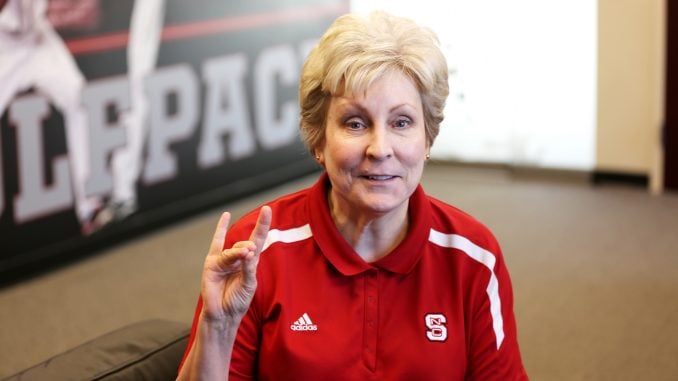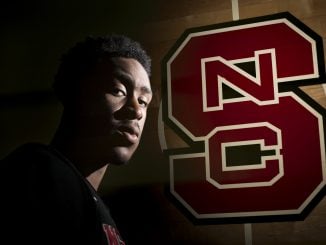
RALEIGH — Debbie Yow raised some eyebrows and invited plenty of social media snark back in June 2010 when she introduced an initiative she called “Wolfpack Unlimited” upon her hiring as NC State’s new athletic director.
It was a bold strategy that proclaimed the status quo to no longer be acceptable while setting the goal of turning State into a top-25 national program.
That seemed like a longshot at the time, with the Wolfpack having finished 89th in the Directors’ Cup standings the previous year and only two of its programs ranked in the national polls at the end of their season.
But eight years later, Yow’s vision has become a reality.
State finished 2017-18 with a school-record 12 ranked programs, with 21 of its 23 teams advancing to the postseason to go along with 12 individual national champions and three team conference titles. Although it will be a few more weeks before the final Director’s Cup standings are announced, the latest update had the Wolfpack at No. 11 — third among ACC schools behind only Duke and Florida State.
As Yow heads into her final year as athletic director, here are her thoughts on the successes her tenure has already achieved and the remaining goals. In part two, she discusses what she still has left to accomplish before her anticipated retirement in June 2019:
NSJ: What was the biggest key in getting the program where you envisioned it could be?
Yow: Getting there has been a process, and there are multiple initiatives that had to be successful. We focused on hiring the right coaches. It starts there. We had to focus on elevating the amount of resources financially and otherwise that were available in 2010. And we had to hire staff who shared the vision and were willing to put the work in behind the scenes to help in any way possible to make the vision become a reality. There is a grind factor in all of this, but you start with the pieces. One without the other won’t work.
What were some of the biggest obstacles you encountered?
We had never had an all-school deal for apparel, so that was something we needed to tackle. We had one of the lowest payouts for multimedia rights in the nation, which was stunning to me the first time I saw it. Then I realized that this is where we were starting from, so let’s buckle up and go to work.
Did the plan yield the desired results sooner or later than you expected?
We had a strategic plan from 2012 through 2017 and the goal was that in 2017 we would finish in the top 25. But we’re going to do it in 2018.
How much satisfaction do you take from accomplishing that goal?
A lot of my satisfaction is rooted in understanding what it could mean for the future of NC State athletics. This university is on an upward trajectory in almost every area under the leadership of chancellor (Randy) Woodson. It’s entirely natural that athletics would be part of that picture. My job for my tenure at NC State is to build a foundation, get us to a certain position where we can then take it from there to the next level.
So what’s the next step for the program?
From a coach’s perspective, having been a coach, I can tell you that the first winning team you have or that first time you’re in the rankings is thrilling. But very shortly thereafter, people want to know what you’re going to do next. And the next thing is consistency. Is it a one-shot deal? What more do we have to do for this to become the norm. Once you establish that as the norm, the next challenge is “how do we take it even higher?” At some point, you establish yourself in the top 25 then you start looking at how you can get past that.
I’ll tell you this, one of the keys to doing that is not comparing yourself to your neighbors. We have two schools within 30 miles of Raleigh that have been excellent across the board for decades. So it makes no sense to do that. We’re competing against ourselves.
Considering the geography and the competitiveness of the rivalries, how difficult a task is it to stay focused on yourself, rather than others — especially when you have fans from other schools trolling State fans about their school’s lack of championships in the highest profile sports.
That’s the interesting dynamic, because we’re not in the Coastal Division and it appears that we’re never going to be in the Coastal Division. Clemson is going to be Clemson. Florida State is going to be Florida State. Louisville is going to be Louisville. It would be easier if we were in a league that didn’t have this level of excellence so that what we achieve might be the top of the pile. That’s now where we are. That’s why it’s foolish to say anything other than what new benchmark can we set for ourselves? The primary one eight years ago was, “Can we become a top-25 program?”
The money required for a level of excellence in the Olympic sports pales in comparison to the investment we make in football and men’s basketball. It should and it always will. But I don’t want to sit at a table at a coaches meeting every month with two coaches that are doing really well and coaches of 21 other sports that are mediocre or bad. You cannot develop a culture of excellence like that.
How can you sum up the kind of culture have you developed at State over these past eight years?
We had a banquet recently that celebrates our athletes’ achievements from the past year, and I heard one athlete say to another: “We’re sitting in the midst of excellence.” That was precious to me because it matters. It changes who you are in a material way as an athletic program if you feel that anything is possible. That’s what we need to do. We need to reinstill hope for all of them, with football and men’s basketball leading the way.


